THE DIFFERENT FILE SHARING NETWORKS
|
| < Day Day Up > |
|
When it comes to file sharing, there are the networks themselves, and there are the programs that actually run on your computer (the client programs). A file sharing network is like a television network, while a client program is like a television that tunes in only to a particular network. Each file sharing network has its own dedicated client program; if you want to use the FastTrack file sharing network, you need to use the Kazaa client. The client is what you use to search for and download files from the file sharing network.
Because the file sharing networks don’t share files among themselves, your chances of finding a particular file are much better if you tap into one of the larger networks or use multiple clients to tap into multiple networks. (Just don’t run two client programs that use the same network, or you’ll just be searching the same network twice.) Here are some of the more popular file sharing networks:
-
Gnutella and Gnutella2 (G2)
-
FastTrack
-
eDonkey and Overnet
-
DirectConnect
-
MP2P
Note Note Be careful when choosing a client program to tap into a file sharing network. Many client programs are free but come loaded with adware or spyware programs that may bombard you with pop-up ads or track your movements on the Internet.
THE GNUTELLA AND GNUTELLA2 (G2) NETWORKS
Gnutella emerged shortly after the demise of the original Napster. Napster’s fatal flaw was relying on a central server to connect computers together, as shown in Figure 2-4. By shutting down this central server, the authorities managed to shut down the entire Napster network.

Figure 2-4: When searching on Napster, every file request first had to go through a central server, which could be shut down.
To prevent this from happening again, Gnutella eliminated the central server and created a completely decentralized network where all computers on the network could communicate directly with each other, as shown in Figure 2-5. Unlike Napster, every computer on the Gnutella network can work independently, so shutting down one computer can never kill the entire network.

Figure 2-5: When searching on Gnutella, every file request goes through every computer connected to the Gnutella network. This makes it impossible for the authorities to shut down the entire network just by removing a single computer.
Gnutella improved upon Napster in another way. While Napster allowed people to share only music files with each other, Gnutella allows people to share all types of files, including music, videos, pictures, and programs.
Strangely enough, the Gnutella network owes part of its existence to the unwitting generosity of America Online, which purchased Nullsoft, publishers of the popular Winamp MP3 player. The programmers at Nullsoft examined Napster’s flaws and created the Gnutella network as an alternative, which they named after a combination of GNU and Nutella, the chocolate-hazelnut spread.
When Nullsoft posted the source code to Gnutella on its website on March 14, 2000, America Online yanked the program within hours, but more than 10,000 people had already downloaded copies and spread them across the Internet. Other programmers studied the way Gnutella worked and created their own client programs to access the Gnutella network. By releasing the source code to Gnutella, Nullsoft’s programmers ensured that the Gnutella network would continue to thrive and develop without the need for further intervention and support from the original programmers. As a result, more file sharing programs tap into the Gnutella network than any other file sharing network in the world.
Gnutella is one of the oldest, largest, and most popular of the file sharing networks, but searching it can be slow. When you request a file, your request goes through every computer connected to the Gnutella network, and they can number in the thousands. Still, many client programs tap into Gnutella for its vast library of file sharing offerings (see Figure 2-6). The following are some popular Gnutella client programs:
Morpheus http://www.morpheus.com
BearShare http://www.bearshare.com
Acquisition http://www.acquisitionx.com
LimeWire http://www.limewire.com
FreeWire http://www.freewirep2p.com
Deepnet Explorer http://www.deepnetexplorer.com
XoloX http://www.xolox.nl
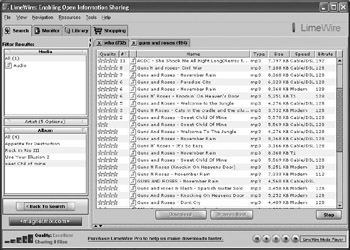
Figure 2-6: The LimeWire client is just one of many clients that can connect to the Gnutella network.
| Note | Note For a current list of Gnutella clients, visit http://www.gnutelliums.com or http://www.gnutella.com/connect. |
Once Gnutella had been running for a while, people began to notice some problems. The more computers that were connected to Gnutella, the slower file searches got, because every file request had to go through each computer. Having to constantly deal with file requests from other computers meant that each computer wasted much of its time processing requests.
To improve upon Gnutella, a programmer designed a new network, based on Gnutella, but dubbed Gnutella2 or G2 (http://www.gnutella2.com). Like the original Gnutella, Gnutella2 remains open source, so anyone can create a client to connect to Gnutella2. The latest version of Morpheus can now connect to both the original Gnutella and the newer Gnutella2 networks. The following clients can connect to both Gnutella and Gnutella2:
Kiwi Alpha http://www.kiwialpha.com
Gnucleus http://www.gnucleus.com
Shareaza http://www.shareaza.com (also connects to BitTorrent and eDonkey2000)
THE FASTTRACK NETWORK
While Gnutella offers an open source network that allows anyone to connect, FastTrack is a closed, proprietary network that only a limited number of clients can access: Kazaa (in various versions), iMesh, and Grokster, as shown in Figure 2-7.
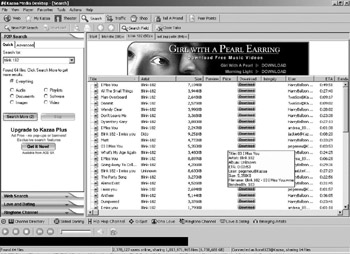
Figure 2-7: Kazaa is one of the most popular, and most sued, file sharing programs in the world.
A Dutch company, called Kazaa BV, created FastTrack shortly before the demise of the original Napster. Based partially on the open source Gnutella protocol, FastTrack improves upon Gnutella by speeding up file searching.
Rather than search every computer for a file like the Gnutella network does, FastTrack routes every file request through Supernodes (shown in Figure 2-8). Supernodes essentially divide the larger network into smaller ones, so searching occurs much more quickly—each Supernode only has to search part of the network. Once a Supernode finds your file, it connects you to that particular computer so you can download the file.

Figure 2-8: FastTrack uses Supernodes, which divide a large network into several smaller ones to speed up file searching.
FastTrack also introduced two other innovations: the ability to resume interrupted downloads and the ability to download a file from multiple sources, both of which can prove especially useful for downloading massive files, such as full-length movies. Finally, FastTrack’s protocol included encryption, which meant that if anyone wanted to create a client program to connect to FastTrack, they had to pay a license fee. Upon its release, FastTrack quickly ran afoul of the recording industry, who successfully sued Kazaa BV. The company soon sold the rights to the FastTrack network to a collection of offshore companies, where the main investor was an Australian company called Sharman Networks.
Further problems occurred between FastTrack’s new owners, Sharman Networks, and the file sharing client Morpheus. When Morpheus refused to pay the licensing fee to stay connected to FastTrack, Sharman Networks rewrote the encryption protocol, effectively shutting out millions of Morpheus users. In retaliation, Morpheus rewrote its client to connect to the Gnutella network instead.
As the most popular file sharing network, FastTrack’s popularity has also made it the number one target of the recording industry. Not only does the recording industry prowl around the FastTrack network, ready to serve subpoenas to people sharing large numbers of files, but they also flood the FastTrack network with bogus files to discourage people from using FastTrack at all. If you use FastTrack, you’re more likely to be sued by the recording industry than if you use a less popular file sharing network.
Despite these problems, the growing popularity of the FastTrack network means that you can probably find a file on this network that you might not find on any other network. Just be aware that the following “official” FastTrack clients come loaded with spyware that can replace your home web page and bombard you with a flurry of pop-up ads:
Kazaa http://www.kazaa.com
Grokster http://www.grokster.com
iMesh http://www.imesh.com
For a while, anyone who wanted to connect to FastTrack without getting bombarded by pop-up ads used an unauthorized program dubbed Kazaa Lite. Kazaa Lite offered the same features as Kazaa, but without the intrusive adware and spyware. (Technically, adware just feeds your computer with a constant stream of advertisements, while spyware keeps track of websites you visit and secretly feeds this information to another computer without your knowledge.)
Naturally the copyright owner of Kazaa, Sharman Networks, wasn’t too pleased with Kazaa Lite, because Kazaa Lite could still use FastTrack while avoiding the advertising that supports the network. Sharman Networks periodically changed the encryption method needed to connect to FastTrack, but with a little reprogramming, Kazaa Lite kept getting reconnected again. For Kazaa, which makes its money by allowing people to trade copyrighted files illegally, to threaten Kazaa Lite with violating their copyright to the FastTrack network seems just a little bit ironic.
To use Kazaa without the advertising, grab a copy of Diet K (http://www.dietk.com), a free add-on program that strips away the advertising embedded in Kazaa. While Sharman Networks can periodically change encryption methods to lock out Kazaa Lite users, they can’t lock out anyone using Diet K, because they’re still using Kazaa.
Two additional ad-free, unauthorized FastTrack clients are Mammoth (http://mammoth.sourceforge.net) and iMesh Light (http://www.imesh-light.com). While Mammoth is an open source project, iMesh Light is a version of iMesh but with the adware stripped away.
Because FastTrack remains proprietary, programmers have created an open source alternative dubbed OpenFT (http://gift.sourceforge.net). Despite their similarities, OpenFT is a separate file sharing network from FastTrack, so if you want the features of FastTrack but without the adware and spyware embedded in Kazaa, you might want to rely on OpenFT instead.
THE EDONKEY2000 AND OVERNET NETWORKS
Although Gnutella and FastTrack allow people to swap any type of file, the most popular files are usually music files that contain individual songs. While you can still find individual songs over the eDonkey2000 (often abbreviated as ed2k) and Overnet networks, you’re much more likely to find files that contain movies, complete albums, video games, pirated software, and ISO disc images (which capture the contents of an entire CD in a single file), as shown in Figure 2-9.
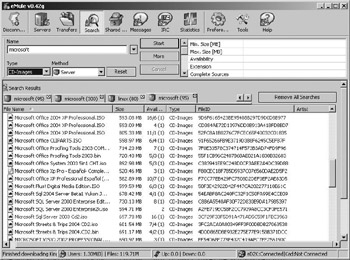
Figure 2-9: A quick search on the eDonkey network reveals plenty of CD images of popular Microsoft programs, including Office 2004, SQL Server, and Streets & Trips.
What makes both eDonkey and Overnet popular for sharing large files is their ability to download a file from multiple sources. By downloading a file from multiple sources, both eDonkey and Overnet ensure that if one computer with your desired file disconnects from the network, you can still download the rest of that same file right away from another computer.
To avoid the confusion caused by similarly named files, both networks examine the contents and size of each file and create a unique calculation known as a hash checksum. This checksum helps identify identical files that may appear on the network under different file names. That way you won’t waste time downloading a movie like The Matrix only to find out that it’s really a misnamed file of another movie called Threat Matrix.
To improve the sharing of large files, both eDonkey and Overnet allow you to start sharing a file before you’ve completely downloaded it. So if you’re downloading a 400MB file, you can start sharing it as soon as you receive just part of that file. Anyone copying that file off your computer may receive their file at nearly the same time that you do without having to wait until you download the complete file first.
Despite their different names, the same people designed both the eDonkeyand Overnet networks. The main difference is that eDonkey relies on a central server (much like the original Napster did) while Overnet does not.
Overnet can connect to both the Overnet and eDonkey networks. However, with eDonkey’s growing popularity, Overnet’s technology is gradually being phased into eDonkey.
Here are some popular client programs for accessing the eDonkey network:
OneMX http://www.onemx.com
eMule http://www.emule-project.net
eDonkey http://www.edonkey2000.com
To access the Overnet network, just use the official Overnet client program (http://www.overnet.com).
THE DIRECTCONNECT NETWORK
Unlike the Gnutella and FastTrack networks, the DirectConnect network is more of a loose collection of central servers than a single unified network. Instead of sharing files among themselves, each server only shares files with people who connect directly to that particular server (hence the network’s name). Figure 2-10 shows a list of servers as seen within the DC++ client.
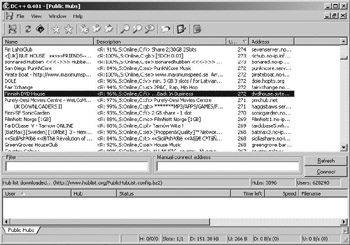
Figure 2-10: Before you can share files over the DirectConnect network, you must find a server that will grant you access to the network.
Each DirectConnect server runs more like a private clubhouse that sets its own rules for who can get access and what trading ratio you need to meet before you’re allowed to download anything. Typically, most DirectConnect servers won’t grant you access unless you agree to share a minimum volume of files, such as 10GB or 20GB. So before you can connect to a DirectConnect server and start sharing files, you must have a library of files to share.
By allowing anyone to create their own server, DirectConnect gives users the chance to specialize in certain types of files, such as jazz MP3 files or blackand-white, silent, full-length movies. Once you find a favorite server that provides the type of files you want, DirectConnect can be much easier to use than other types of networks. As a novice to DirectConnect, though, you’ll have to spend some time browsing through different servers until you find the ones that you like best. Plus, you’ll need to amass a collection of files to share, just to get access to any DirectConnect server.
Three programs for connecting to the DirectConnect network include:
DirectConnect http://www.neo-modus.com
DC++ http://dcplusplus.sourceforge.net
DCGui http://dcgui.berlios.de
THE MP2P NETWORK
While other networks offer video, program, and graphic files, the Manolito P2P (MP2P) network originally focused on nothing but MP3 music files. If all you want to find is music, then you’ll find the Manolito network is a treasure trove for finding rare and bootleg music that you probably won’t find anywhere else. Although people have recently started sharing other types of files besides music over this network, MP3 music files still dominate the file offerings.
While most file sharing networks have only one official client program, the MP2P network actually has three official clients, although Piolet (shown in Figure 2-11) doesn’t come bogged down with adware like the other two clients, Blubster and Rockitnet:
Blubster http://www.blubster.com
Piolet http://www.piolet.com
Rockitnet http://www.rockitnet.com
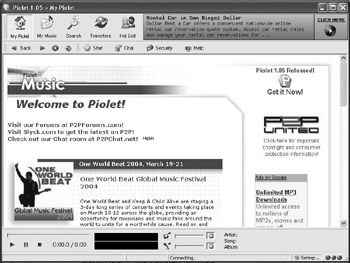
Figure 2-11: Piolet is advertiser-supported, but the ads only appear in a banner within the program; they’re not embedded in hard-to-remove adware.
|
| < Day Day Up > |
|
EAN: 2147483647
Pages: 98
- An Emerging Strategy for E-Business IT Governance
- Linking the IT Balanced Scorecard to the Business Objectives at a Major Canadian Financial Group
- Measuring and Managing E-Business Initiatives Through the Balanced Scorecard
- Governing Information Technology Through COBIT
- The Evolution of IT Governance at NB Power